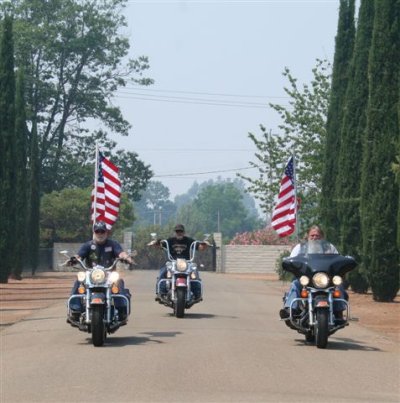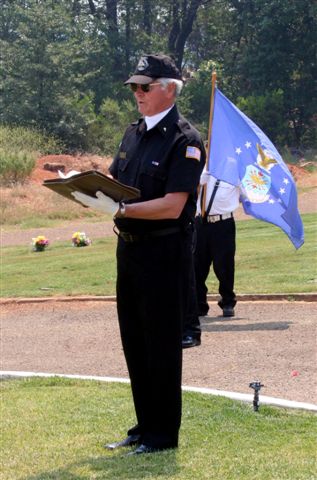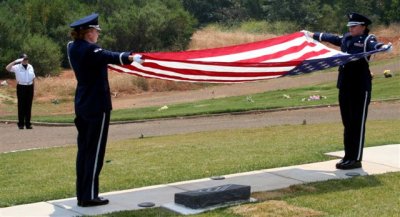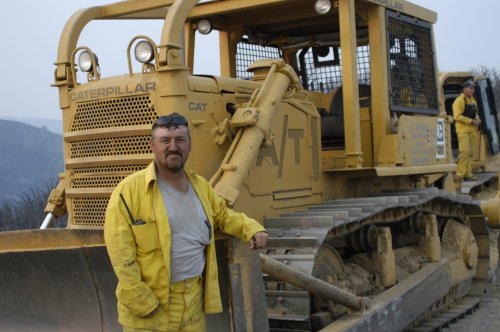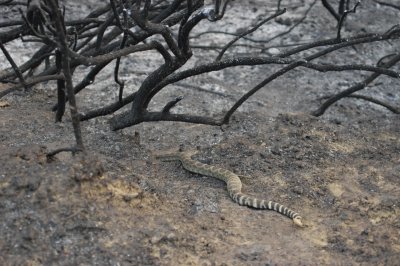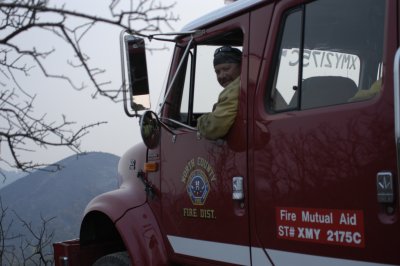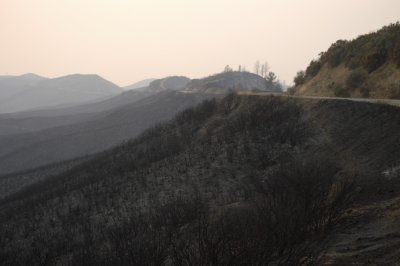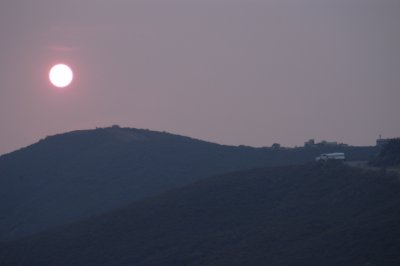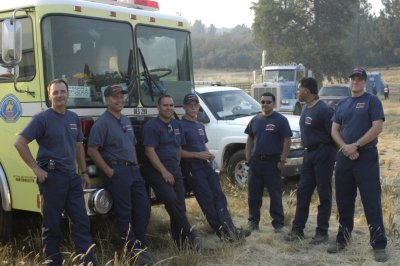
Firefighters from a strike team from Kings and Fresno counties, including engineer Bill Williams (left) and Capt. Pat Papasergia (second from left) from Bakersfield Fire, wait to find out their assignment at the Konocti Conservation Camp on Tuesday, June 24, 2008. The men had arrived earlier in the day from the Wild Fire in Napa and Sonoma counties. Photo by Elizabeth Larson.
KONOCTI CONSERVATION CAMP – The Walker Fire made another huge leap in size late Tuesday, reaching an estimated 14,000 acres as firefighters attempted to set backfires to keep it away from homes and Highway 20.
Dan Sendek, division chief for safety and training at Cal Fire's Sonoma-Lake-Napa Unit's Delta Camp in Suisun City, said the fire – burning since Sunday – had reached 14,000 acres by 7 p.m., with only 5-percent containment.
Cal Fire is estimating the fire – located in mostly remote wildlands about 14 miles east of Clearlake Oaks – could eventually burn as much as 35,000 acres. No timeframe for containment has been given.
According to Cal Fire a total of 35 homes are threatened, 25 of them in the Double Eagle Ranch Subdivision, which was evacuated Sunday.
On Tuesday, two helicopters worked on dropping water on the fire, said Sendek, but air operations were not as extensive as they were on Monday, when Cal Fire sent in a DC-10 air tanker to drop retardant.
Firefighters lit backfires during the night and into the afternoon along Walker Ridge, said Sendek, in an attempt to stop the fire's advance toward Highway 20, which could force a closure.
The effort was "not terribly successful" due to too much humidity, Sendek said.
Incident Command Team Three is guiding the effort, said Sendek. It's one of 10 such teams in the state, four of which currently are in Northern California.
Operations are now headquartered at Konocti Conservation Camp, located off of Highway 29 between Kelseyville and Lower Lake.
By Tuesday evening, a total of 240 firefighters were on scene at the camp, said Sendek. The doubling since yesterday in the size of the firefighting force was largely due to the release of about half of the 500 or so firefighters at the Wild Fire, which burned more than 4,000 acres in Solano and Napa counties.
The Walker and Wild fires are now referred to as the Walker Complex, said Sendek, and both are being managed jointly from the camp.
A major goal was getting more firefighters on the incident in order to give some rest to the local and state fire crews who have been on the Walker Fire since Sunday. Initial responders had included all local fire districts along with Cal Fire.
"They'll work until they drop,” said Sendek. “We just don't want that to happen."
More firefighters are expected to arrive in the coming days, said Sendek, as they're released from other fire assignments.
"The expectation is, no one is going home," he said. "If they go anywhere, they're coming here."
Firefighters come from around the state
Strike teams from around the state were pulling into the camp Tuesday afternoon and evening, where they were waiting to find out their assignments for the Wednesday.
Frank Rohan, a battalion chief with the Kings County Fire Department and a leader of a strike team composed of engines from the Office of Emergency Services, and Captain Brian Torosian of the Clovis Fire Department were among those pulling into camp Tuesday from the Wild Fire. Their five-engine strike team also included members from the Bakersfield, Porterville and Fresno County fire departments.
Lake County was just another stop for the men in what has been months of firefighting. Rohan had been at the Summit Fire in Santa Cruz, and Torosian at the Humboldt in Butte County.
"People are being sent everywhere right now," said Rohan.
If there's anything they're noticing, it's that Northern California is having more trouble earlier in the season.
"Most of the action has been happening here this summer," said Rohan, rather than in the drier Southern California climates.
Engineer Bill Williams, a strike team member from Bakersfield Fire Department, said they're also seeing "more erratic fire behavior" on the fire lines. That includes trees, bushes and other vegetation that don't usually burn this time of year going up in flame.
Captain Pat Papasergia of Bakersfield Fire said sudden oak death also had proved to be a problem, with healthy looking trees suddenly collapsing in the fire areas.
Along with the firefighters arriving from the Wild Fire came a firefighter encampment that workers were in the process of setting up Tuesday evening in the little valley where the conservation camp sits.
There was a portable kitchen, a large tent area for meals, banks of portable toilets, dumpsters and other necessities put in place. Crews were busy weed whacking to clear a defensible space around the perimeter. Smoke from the region's fires hung thick in the air, turning the sun into a giant, blood-red ball.

Inmate crews were setting up the firefighters' encampment at Konocti Conservation Camp on the evening of Tuesday, June 24, 2008. Photo by Elizabeth Larson.
As many as 800 firefighters could arrive at the camp in the days ahead, said Sendek, as more firefighters are released from other incidents.
Six inmate crews also have been sent to join the effort, said Sendek. The Walker Fire is not currently in the state's top three fires, which is where California National Guard members activated by the governor are headed.
In an effort to track the exact size of the fire, Kimberley Sone, a Cal Fire assistant state forest manager stationed at Boggs Mountain, said she'll walk the fire line on Wednesday, carrying a GPS device which will track the Walker Fire's precise dimensions.
With a big fire like the Walker, winds that come up can cause “long range spotting,” Sone explained. That means the wind picks up parts of the fire and carries them long distances, creating spot fires away from the fire's main body. Resources then need to be sent to deal with those spot fires individually.
On Tuesday Cal Fire reported that 842 lightning fires were burning throughout the state. The Associated Press reported the fires resulted from more than 8,000 strikes in the storm last weekend.
“You just can't plan for that,” Sendek said.
He added, “I'm sure there are still fires out there people haven't found.”
Sendek said the fires have hit before the Sonoma-Lake-Napa Unit's peak summer staffing levels, which don't begin until July 1.
There are no cost estimates yet on how much the firefighting effort will cost.
More help may be on the way. The Associated Press reported Tuesday that Oregon is sending 2,400 firefighters to aid in the battle against California's wildland fires.
E-mail Elizabeth Larson at This email address is being protected from spambots. You need JavaScript enabled to view it..

Firefighters set up their own places to sleep at the camp on Tuesday, June 24, 2008. Photo by Elizabeth Larson.
{mos_sb_discuss:2}


